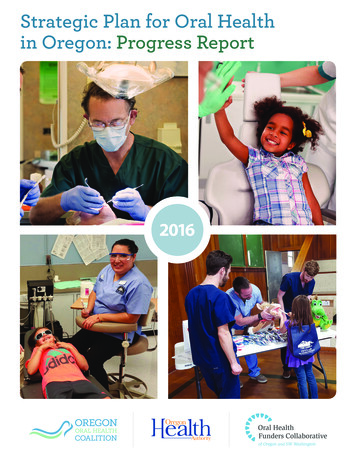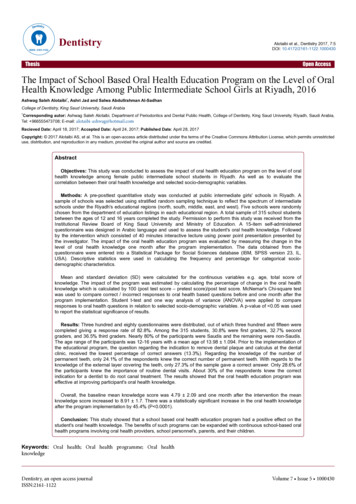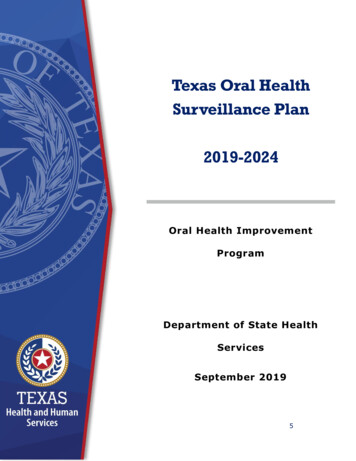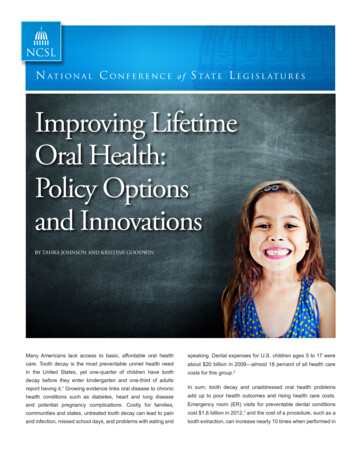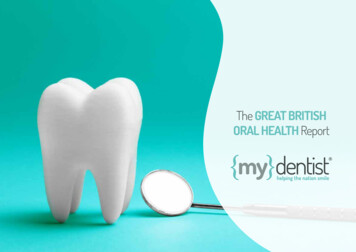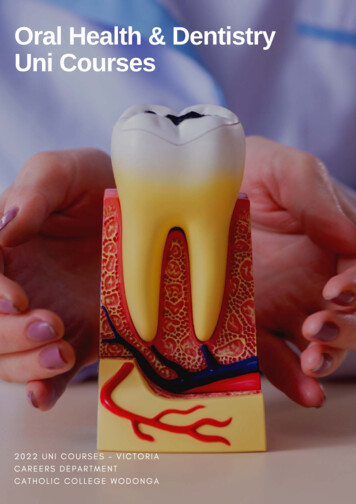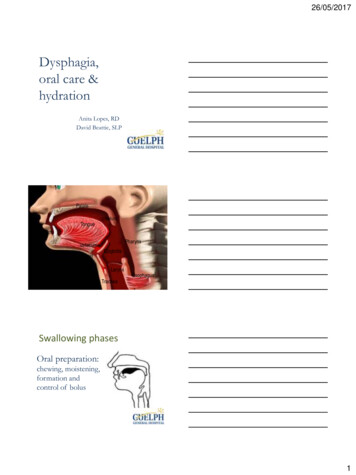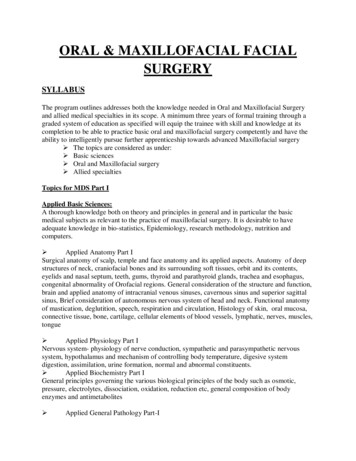
Transcription
PORTRAITOF ORALHEALTHIN NORTHCAROLINAA Report from the North Carolina Oral Health CollaborativeA program of the Foundation for Health Leadership & InnovationAn Overview of Our Current Realitiesand Opportunities for ChangeNC ORAL HEALTHC O L L A B O R AT I V Ea program of the Foundation for Health Leadership & Innovationwww.oralhealthnc.org1
ContentsPerspective on the State’s Oral Health:Is it Time for a North Carolina Dental Moonshot?. 3Executive Summary. 4Accessing the North Carolina Oral Health Care System. 12Through the Lifespan: How Well is the System Meeting the Need?. 16Children & AdolescentsAdultsWorkforceCommunity Water FluoridationOpportunities for Action. 25Conclusions. 26Additional Resources. 27Appendix. 28References. 312
Perspective on the State’s OralHealth: Is it Time for aNorth Carolina Dental Moonshot?Written by: R. Gary Rozier, DDS, MPHResearch ProfessorDepartment of Health Policy and ManagementGillings School of Global Public HealthUniversity of North Carolina at Chapel HillChapel Hill, North CarolinaRemarkable progress has been made in addressing the oralhealth of North Carolinians over the last several decades. A lookback at but one outcome measure provides a revealing picture.In the early 1960s more than 2,000 students in North Carolina had lostall of their permanent teeth to dental disease before graduation fromhigh school. There was only 1 dentist for every 4,000 people at thattime, fewer than 100 dental hygienists practiced in the entire state,and only 15% of the population was drinking fluoridated water.Today, a downward trend in dental caries in permanent teeth ofchildren and adolescents first identified in the 1970s has reachedhistoric low levels. Complete tooth loss from dental disease hasplummeted in the last 50 years and has all but been eliminated inupper-income groups. In short, dramatic reductions in the burdenof disease are possible and have been achieved for many NorthCarolinians.One negative trend stands out: now, for the most part, dental diseaseis concentrated in lower-income populations. This gap in dentaldisease between lower- and other-income groups should come as nosurprise when one considers concurrent trends in social determinantsof disease. The population is growing, and as it does, is getting older,more diverse and more deeply divided by income.growing inequalities in oral health. The current dental care system willcontinue to benefit many people, but simply improving access to thiscare is unlikely to be entirely effective in high-risk individuals.It is time for North Carolina to undertake an aggressive agenda,a moonshot if you will, that includes strategies that deal with theunderlying social, economic and political causes of oral healthinequalities. Strategies are important on three major fronts. First, we need to continue to address traditional access barriersto the current dental care system, such as lack of dental insurance,through innovative solutions that consider social determinants(e.g., integration of oral health services into medical care and socialservice programs). Second, strategies are needed to improve dental care for those whohave access so that more productive interactions occur with patientshaving low literacy or language barriers (e.g., patient-centered care,provider communication skills training). Third, broader policies need to be considered that will help reduceinequalities caused by social determinants (e.g., promote theavailability of oral health preventive services in programs such asHead Start, WIC and long term care; provide intense family supportservices for high risk individuals; give priority to prevention and earlyintervention).Such a multifaceted approach involving access, improvementsin the current dental care system and policy development is notwithout its challenges. It would be complex to plan and implement,difficult to engage fully the necessary disciplines inside and outsideof dentistry, challenging to develop a consensus vision around howto move forward, at risk of falling back on current approaches thatare not working for many people, and would require community-bycommunity action in addition to regional and state activities. But thenit is a moonshot that we need!“Every system is perfectly designed to get the results it gets!”is a short, magical quote that has become a guiding principle forhealthcare change in the United States. It is increasingly apparent thatthe current healthcare system is unable to respond effectively to the3
Executive SummaryNorth Carolina has made noteworthy progress in the arena oforal health in recent years, yet inequities in access to care areunacceptably pervasive. Poor oral health results in more than justtooth decay. It has consequences that dramatically lower quality oflife, impacting overall health, self-esteem, the ability to learn andemployability. While there is a proven connection between individualhealth literacy and health outcomes, inequities in oral health amongNorth Carolina residents are largely a function of how our oral healthcare system is structured.NC Statistics at a Glance:Citations for all statistics within the Executive Summaryappear in the body of the document.The Portrait of Oral Health in North Carolina is intended to providea rich overview of the current state of oral health in North Carolina,acknowledging the progress that has been made since the 1999 NCInstitute of Medicine Report8, while highlighting the challenges thatpersist and the opportunities for systemic change. Emergency department dental visits per 10,000 populationin NC: 87.8 (more than twice the national rate and thefastest growing compared to other southeastern states).Accessing the North Carolina OralHealth Care System: 55% of American Indian and 52% of Hispanic children(compared to 30% of white children with untreatedtooth decay.).The U.S. health care system is structured such that a person’s abilityto access care is largely determined by his or her ability to pay. Thisis even more so the case for oral health care. The out-of-pocketexpenses for dental care can be prohibitive, even for someonewith private insurance. On average, out-of-pocket expenses fordental care are more than three times higher than for medical care.Furthermore, lack of dental coverage and/or ability to pay pose evengreater barriers for rural populations, who are already challenged byfewer dental providers to access for care.In addition to costs, geography and limited capacity of safety netclinics also pose barriers to care. Such inequities in access have andwill continue to perpetuate disparities in oral health outcomes unlesssystemic changes are made.4Through the Lifespan:How Well is the SystemMeeting the Need? 13% of kindergartners with untreated decay. 21% of North Carolinians over age 65 have lost all of theirnatural teeth. Dentists are heavily concentrated in 1/5 of the counties.There are 3 counties with no dentists. 27% of dentists in NC participated in Medicaid in 2014(compared to 42% nationally).
Children & Adolescents: Tooth decay continues to be the mostcommon chronic disease of childhood. Poor oral health has greatimpact on the development and well-being of children. Children withdental problems and pain are more likely to have performance issuesduring the school day, nearly 3 times more likely to miss school, andless likely to complete homework assignments.Adults: Poor oral health can significantly diminish quality of life ina number of ways – the most obvious being a person’s ability toeat, sleep and speak. However, there are also social and economicconsequences that can impact a person’s job readiness andperformance, and ultimately the economic stability of communities.Pregnant Women: A woman’s health plays an important role in thehealth of her children, and this includes oral health. When parentssuffer from dental decay, they can transmit the harmful bacteria thatcauses decay to their children through seemingly innocent behaviorssuch as sharing eating utensils.Frail Elderly: Older adults, particularly those residing in assistedliving and long-term care facilities, also suffer disproportionately fromoral diseases and conditions. If they are able to access care, mostolder adults experience high out-of-pocket expenses as Medicaredoes not cover dental services.Workforce: The dentist-to-population ratio in North Carolinacontinues to lag behind the national average. However, far moreconcerning is the fact that North Carolina dentists are heavilyconcentrated in one-fifth of the state’s counties–primarily suburbanand urban areas.Community Water Fluoridation: Fluoridation of community watersystems has contributed greatly to the decline in tooth decay in theU.S. Of North Carolina residents served by public water systems, 88%receive fluoridated water – higher than the national average.It is critical that North Carolina at least maintain this level of coverageand avoid rolling back decades of progress in fighting dental decay.Opportunities for ActionOver the last 40 years, oral health status has improved dramatically forthose with access to care, but not for those populations that strugglewith systemic barriers to accessing care. There are opportunitiesbefore North Carolina to make systemic change that addresses boththe supply and demand for oral health care, and effectively begins toclose the gaps in oral health access and outcomes.Supply-Side Strategies:Address Shortage and Maldistribution of Dentists: Strategiesshould be considered that incentivize dentists from oversaturatedareas to provide care to these rural communities as an extension oftheir practices. Employing new service delivery models, such as theVirtual Dental Home via teledentistry, is a proven vehicle for extendingneeded preventive care into communities and referrals through theeffective and efficient use of the allied dental workforce.Maximize Use of Existing Supervision Provisions in the DentalPractice Act: Provisions have been made to allow dental hygieniststo provide care in certain settings with out direct supervision by adentist, via 16W Public Health Hygienists and 16Z Limited SupervisionHygienists. Given that these provisions are underutilized, additionalefforts to enable allied dental personnel to work to the full extent oftheir education and training to meet the needs of more NorthCarolinians should be considered.Expand Access to Dental Hygienists: While it varies by state,39 states allow a licensed certified dental hygienist to assesspatients and offer a limited scope of treatment without the specificauthorization or on-site presence of a supervising dentist. Allowinghygienists to provide these services, which are well within theirtraining and experience, would increase access to preventive servicesin high-risk populations and community settings including nursingfacilities, schools and day cares.5
Increase Medicaid Reimbursement Rates: Increasing Medicaiddental reimbursement rates has been shown in North Carolina andother states to quickly increase provider participation and patientutilization rates. Because the vast majority of North Carolinadental providers are private practitioners, they are critical to closingthe disparities gaps. The dental safety net system cannot bear theentire burden and charity care is not a solution.Common Sense in Value Based System: The health care systemis moving toward value-based approaches to financing care.Within such a system the impact of oral disease on costs associatedwith improved overall health outcomes has the potential to playa significant role. Poor oral health has a direct impact on healthoutcomes for adults with diabetes and other chronic conditions.The costs and risks related to overall health outcomes for these andother populations, due to poor oral health, will be transferred to thoseentities responsible for improving population health outcomes.Promote and Spread Innovation: There are successful, innovativeprograms operating all across North Carolina that are increasingaccess to care for some of the state’s most vulnerable populations ashighlighted in our NC Oral Health Innovation Bank Report. Investingin statewide adoption of some of these promising practicesis one way to ensure North Carolina solutions for North Carolinaproblems.ConclusionsThrough the implementation of several of the 1999 NCIOMrecommendations, innovative strategies in prevention and earlyintervention, and a robust state dental public health program, NorthCarolina has certainly experienced gains in oral health in the last 15years – most notably among its youngest residents. Unfortunately,these improvements have not been equally felt by all children andadults, begging the question: who is left behind, and why?Demand-Side Strategies:Protect Existing Medicaid Benefits and Expand Coverage:The loss of existing dental benefits for children or adults would furtherdisenfranchise a population that is already socially and economicallyoverburdened, and the health care system would eventually bearunnecessary expense. Expanding Medicaid to cover more low-incomeand vulnerable individuals would greatly improve access for thosewho currently may be using inadequate or inappropriate sources ofdental care, or who are not accessing the system at all.Bring the Mouth Back Into the Body:Efforts towards oral health-primary care integration are essential if thepublic – patients, providers, and payers alike – are to truly embraceoral health as an essential component of overall health.The continued separation of medical and dental, in education,training, clinical practice, payment systems and in reform efforts,undermine integration and send a message that oral health care isancillary.6Given the proportion of underinsured and uninsured individuals inNorth Carolina, the current oral health care system is not structured tomeet the needs of far too many. North Carolina must invest in longterm, sustainable strategies that empower both oral health providersto deliver needed care to more people and patients to seek the carethey so desperately need. Recent decades of experience make itclear that we have the technical solutions and the human resourcesto improve oral health. Therefore, this is not a challenge of science,but rather one of leadership and political will to make oral healthachievable for all.By coming together to modernize our oral health system, we’ll notonly improve outcomes but also reduce costs. The opportunities totake action have presented themselves time and time again, and thepeople of North Carolina are saying there is no time like the present.
AcknowledgementsThis report was prepared during the Spring of 2017 by the North Carolina Oral Health Collaborativea program of the Foundation for Health Leadership and Innovation.PROJECT TEAMMomsRising Education FundRaleigh, NCRhonda Stephens, DDS, MPHNorth Carolina Oral Health CollaborativeCary, NCThe Cornerstone CDCWarsaw, NCZulayka Santiago, MPANorth Carolina Oral Health CollaborativeCary, NCCONTRIBUTORSJabari BrooksLeighton HarrellJacquelyn HedrickCaroline LeYouth Empowered Solutions (YES!)Raleigh, NCElaine MatthewsRaleigh, NCNC DHHS Division of Medical AssistanceRaleigh, NCNC DHHS Office of Rural HealthRaleigh, NCThe Arc of North CarolinaRaleigh, NCEl Pueblo, IncRaleigh, NCNorth Carolina Parent Teacher AssociationRaleigh, NCStudent Action with FarmworkersDurham, NCAMEXCANGreenville, NCR. Gary Rozier, DDS, MPHUniversity of North CarolinaGillings School of Global Public HealthChapel Hill, NCNC Oral Health Innovation Bank Report ContributorsDr. Sharon Nicholson Harrell, FirstHealth Dental CareRegina Smith, Montgomery County School Health CentersDr. Bill Donigan, Gaston Family Health Services Dental ClinicDr. Bill Milner, Access Dental CareDr. Paul Glassman, Arthur A. Dugoni School of Dentistry7
REVIEWERSAlex White, DDS, DrPHUniversity of North CarolinaGillings School of Global Public HealthChapel Hill, NCJane Weintraub, DDS, MPHUniversity of North Carolina School of Dentistry,Chapel HillKatie Eyes, MSWBlue Cross and Blue Shield of NorthCarolina FoundationDurham, NCLew Lampiris, DDS, MPHUniversity of North CarolinaSchool of DentistryChapel Hill, NCStacy WarrenThe Duke EndowmentCharlotte, NCSteve Cline, DDS, MPHCommunity Care of North CarolinaRaleigh, NCPRODUCTION ASSISTANTSNapoleon Wright IIPan II CreativeRaleigh, NCLisa Baker Godfrey, MS, RDH, CDACentral Carolina Community CollegeSanford, NCThe NC Oral Health Collaborative is supported bygrant funding from:Maggie SauerFoundation for Health Leadership & InnovationCary, NCThe DentaQuest FoundationThe BlueCross BlueShield Foundation of North CarolinaThe Duke EndowmentParrish RavelliYouth Empowered Solutions (YES!)Raleigh, NC8Sarah VidrineNC ChildRaleigh, NC
About the NCOHCPrefaceThe North Carolina Oral Health Collaborative (NCOHC) was formed in2013 with the recognition that there is undeniable power in collectiveaction. The NCOHC convenes diverse stakeholders to identify andresolve consumer-level and systemic barriers to optimal oral healthand accelerate implementation of policies and practices that reduceoral health disparities and promote improved oral health for all NorthCarolinians.The release of Oral Health In America: A Report of the SurgeonGeneral in 2000 prompted significant dialogue around a matter ofhealth that had previously garnered very little national attention.Greater recognition was given to the chronic, yet preventable,nature of oral diseases, the disproportionate burden of oral diseaseexperienced by many of the country’s most vulnerable populations,and the broader impact of oral health on overall health and qualityof life. This dialogue has subsequently resulted in the developmentof numerous partnerships at all levels of government and non-profitorganizations to develop strategies for improvement, and progresshas since been made.1Our collective work is to ensure that all North Carolinians have accessto quality dental care, provided by someone they trust, in a timelyand compassionate manner, regardless of geographic residence,socioeconomic background, race and ethnicity, age or mental/physical ability.Transforming the landscape of oral health in our state requires us towork across differences in sectors, political ideology, program silos,and geography towards common goals. Undoubtedly, there is greatpotential for dramatic change within our lifetime. Fewer children and adolescents have untreated tooth decay andmore school-age children are receiving dental sealants.2 Periodontal (gum) disease and untreated tooth decay has decreasedamong adults, consequently adults are retaining their teeth longer.3 More Americans are benefitting from optimally-fluoridatedcommunity water systems.4The North Carolina Oral Health Collaborative is a programof the Foundation for Health Leadership and Innovation.The Foundation is a nonprofit organization that developsand supports innovative programs and partnerships thatadvance affordable and sustainable quality health servicesto improve the overall health of communities in NorthCarolina and beyond. The connection between oral health and overall health has beenfurther emphasized by research suggesting stronger relationshipsbetween oral health and a variety of conditions, including diabetes,cardiovascular disease and adverse birth outcomes.1However, despite these overall improvements in oral health, somepopulations continue to be disproportionately plagued by poor oralhealth. Inadequate access to care continues to be a challenge for manyAmericans, because an estimated 126 million people do not havedental insurance.1 Rural populations tend to have lower dental care utilization, lowerrates of insurance, higher rates of poverty, less water fluoridation,fewer dentists per population, and greater distances to travel toaccess care than urban populations.59
Non-Hispanic blacks, Hispanics, and American Indians and AlaskaNatives generally have the poorest oral health of any racial and ethnicgroup in the United States.6 Adults with less than a high school education experience toothdecay and destructive periodontal (gum) disease nearly three timesthat of adults with at least some college education.6 Older adults age 65–74 living below the federal poverty level arenearly three times more likely to have lost all of their natural teeththan older adults living above the poverty level.7As the first state to implement a state oral health program nearly100 years ago, North Carolina has demonstrated a commitmentto the oral health of its residents. Through a robust dental publichealth program, North Carolina has been able to continually monitorthe oral health of its children and respond to their needs through thecoordinated provision of preventive services such as school-basedsealant and fluoride mouth rinse programs, education, and referralsto dental providers. As a result of the program and its emphasis onprevention, North Carolina has experienced clear improvements inoverall oral health, particularly for children. However, like other states,North Carolina continues to experience many of the same oral healthdisparities seen at the national level.At the direction of the North Carolina General Assembly, the NorthCarolina Institute of Medicine (NCIOM) Task Force on Dental CareAccess was convened in 1998 to evaluate and develop strategies toimprove access to dental care, particularly for the state’s Medicaidpopulation. The Task Force acknowledged that inadequate accessto dental care was commonplace among individuals living inpoverty, often resulting in severe or chronic pain, inability to eat orspeak, missed days of school and work, and increased susceptibilityto other medical conditions.8 The 1999 final report included 23recommendations to address 1) dentist participation in Medicaid, 2)the supply of dentists and dental hygienists serving underserved areasand populations, 3) the supply of pediatric dentists and provision ofpreventive dental services to children, 4) training dental professionalsto treat special needs patients, and 5) educating Medicaid recipientson the importance of routine oral health care.8 See Appendix forcomplete list of recommendations.10The status of the Task Force’s recommendations was reviewedsix years later during the 2005 NC Oral Health Summit. Summitparticipants reviewed the original recommendations to determinetheir current relevance, what steps had been taken towardsimplementation, and ultimately made recommendations to eithercontinue with implementation or develop new strategies altogether.Overall, Summit participants concluded that the majority ofrecommendations had technically been implemented, but stressedthe need for ongoing efforts to sustain and improve their impact.9The Portrait of Oral Health in North Carolina is intended to providea rich overview of the current state of oral health in North Carolina,acknowledging the progress that has been made since the 1999NCIOM report, while highlighting the challenges that persist and theopportunities for systemic change. As important context to this stateof oral health, the report begins with a schematic representation andexplanation of the oral health care system in North Carolina and howit is typically accessed by individuals and families based on dentalinsurance status.How well the system is meeting the oral health needs of residentsat different life stages is then described through the presentation oftraditional quantitative data (ie oral health indicators and related data)supplemented by real stories from North Carolinians most directlyaffected by lingering oral health inequities. Promising programs andpractices that are attempting to address access to care issues are alsohighlighted throughout this section of the report.The details of these programs have been collected from across NorthCarolina and beyond as part of a larger project called the Oral HealthInnovation Bank. See Additional Resources.Taking into account the current state of oral health and previousattempts to improve access to care, the report concludes with acandid discussion of the opportunities before North Carolina to makesubstantive change to its oral health care system – change that willbring us closer to achieving oral health equity.
27%65%9%Insurance Status ofPrivate Dental Practice PatientsUninsuredPublic InsurancePrivate InsuranceReference Number: 1411
Accessing the North CarolinaOral Health Care SystemThe U.S. health care system is structured such that a person’s abilityto access care is largely determined by his or her ability to pay. Thisis even more so the case for oral health care. In 2015, 84% of NorthCarolinians with any dental benefit had a dental visit, compared to61% of those without dental benefits.10 However, while having dentalcoverage is certainly more beneficial than no coverage at all, it doesnot guarantee access to care - or more specifically, the care a personmay need.Private Dental PracticesPrivate practice, whether a solo practitioner or group practice, isthe most common setting in which the general public receivesdental care. In 2016 approximately 76% of North Carolina dentists,or 4,566 , are in private practice,13 the majority of whom are generalpractitioners, which means their practice typically provides a broadrange of dental services. The fees charged in private practice tendto be the highest of the care settings discussed here, which may inpart explain why nationally, private practices are largely made up ofprivately insured patients.14Dental Schools“My job does [provide dentalinsurance], but the dentist that Iwas going to was costing me toomuch money to get it done. You canhave insurance with your companyfor dental, but a lot of thingsaren’t covered.”Patient at a Charity ClinicThe out-of-pocket expenses for dental care can be prohibitive, evenfor someone with private insurance. On average, out-of-pocketexpenses for dental care are more than three times higher than formedical care.11 Two national household surveys of low- and middleincome households with credit card debt found dental expenses tobe a leading contributor to medical debt in 2012.12 Furthermore, lackof dental coverage and/or ability to pay pose even greater barriersfor rural populations, who are already challenged by fewer dentalproviders to access for care. The following narrative briefly describesthe various entry points into the North Carolina oral health caresystem and some of the opportunities and challenges each pose tothe patient population.12The University of North Carolina School of Dentistry (UNC), EastCarolina University School of Dental Medicine (ECU) and communitycollege Dental Hygiene programs across the state are also a sourceof dental care for North Carolinians. UNC provides comprehensiveprimary and specialty dental services through its student and facultypractice clinics. UNC also hosts the Student Health Action Coalition(SHAC) which is a student led organization whose mission is toprovide free health services to uninsured and underinsured. TheDental Clinic operates on select Wednesday nights and sees patientson a walk-in lottery system (no appointments). Students also providecharitable care at multiple free clinics in the Triangle area.Having just opened in 2011, ECU currently provides comprehensiveprimary services and limited specialty care. The fees charged bydental school clinics tend to be slightly less than those of privatedental practice, and both institutions accept most private insuranceplans, as well as Medicaid and NC Health Choice. Receivingtreatment at a dental school can however come with additional costs:time and travel. Some patients may drive several hours to receivecare, if the dental school is their only or best option. Additionally,inherent to receiving care from student providers is significantlylonger appointment times – often two to three hours. Yet bothinstitutions attempt to alleviate these barriers by providing free orlow-cost services through a variety of community outreach programs.ECU opened with a particular emphasis on providing and enhancingoral health services for underserved North Carolinians and recruiting
qualified students from historically underrepresented groups,disadvantaged backgrounds, and underserved areas, understandingthat they are likely to practice in similar communities. In addition todental services offered at the school’s primary location in Greenville,NC, the school also operates eight satellite Community ServiceLearning Centers in underserved areas across the state. Thesesites are able to provide some reduced-cost dental care to eligiblepatients. It is important to note that historically UNC has also been anational leader in enrolling underrepresented and minority students.There are 12 community college dental hygiene programs in thestate.15 In addition to training future hygienists, these programsoperate dental hygiene clinics, whereby the students provide dentalcleanings and other basic preventive services to the public; patientsrequiring additional treatment, such as restorations and extractions,are referred to a dental office.Dental Safety Net SystemThe safety net health care system is regarded as the default system ofcare for uninsured, Medicaid, and other vulnerable populations.16The system is not uniformly availab
the supply and demand for oral health care, and effectively begins to close the gaps in oral health access and outcomes. Supply-Side Strategies: Address Shortage and Maldistribution of Dentists: Strategies should be considered that incentivize dentists from oversaturated areas to provide care to these rural communities as an extension of
